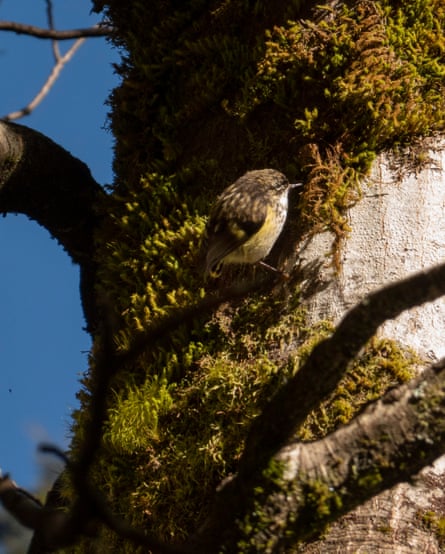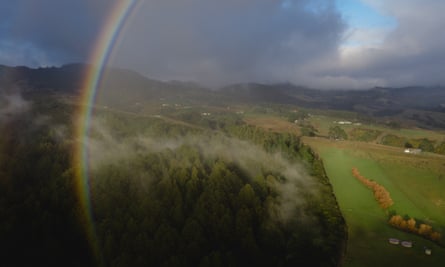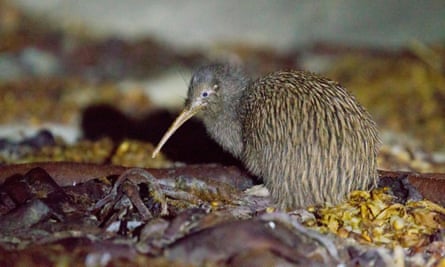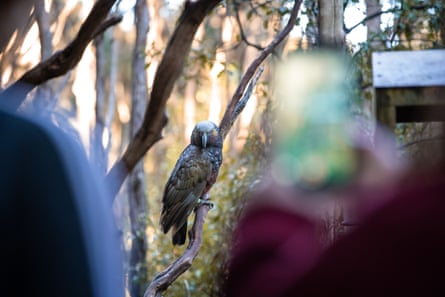
The forest is making a racket. I pause to listen near a 400 year-old rimu tree with my Orokonui Ecosanctuary guide, Taylor Davies-Colley. The melodious flute, bells and whistles of the korimako/bellbird are the loudest, followed by the tūī’s rapid-fire flips between clicks, rattles and bleeps, which sound more like the labouring of an experimental composer than a forest bird.
“Can you hear that?” says Davies-Colley. “Can I hear what?” I reply. I can hear lots of things, but nothing I can name. After a fortnight feeling reasonably at home in Aotearoa New Zealand, this land suddenly feels very foreign.
My guide’s ear is tuned to avian frequencies, thanks to four years strolling the ecosanctuary’s 307 hectares (758 acres), and he’s heard the ‘zeet zeet’ of Aotearoa’s smallest bird, the titipounamu/rifleman, an ancient wren with no tail that’s the size of a golf ball. “See that wobbling leaf?” he says. “That’s where he was. He hit that leaf!”
A whooshing noise overhead makes me duck. “What was that?” I say. “Tūī,” he says. “They’re noisy flappers but you should hear the wood pigeon. We have a flock of about 20 and they just cause mayhem. They move in a group and when they get startled, you get startled too, it’s hilarious.”
Orokonui is a 25 minute drive from Ōtepoti Dunedin. You won’t see tour buses pulling up here but you will see couples, cute families and lots of solo birders – identified less by their quick-reach binos than their sense of purpose and immersion. Nine walking tracks meander through native forest, over creek bridges and across grassy meadows. The entry fee (adults NZD$20; children NZD$10) sustains the sanctuary’s conservation work, with cultural guidance from mana whenua, Kati Huirapa Runaka ki Puketeraki, with their Kaitiaki (guardianship) of this land.
“One of the things we are trying to achieve is birds just everywhere, like what pre-mammal New Zealand would’ve been like,” says Davies-Colley.
Does everyone remember when they first learned Aotearoa had no native land mammals? I do. I made it to my mid-20s, and to Aotearoa itself, before finding out. Only bats and ocean mammals pre-date humans. Māori bought the Polynesian rat, Europeans introduced stoats, possums, rabbits, mice and more, not to mention mass land clearing.
Invasive fauna and flora continue to ravage Aotearoa’s unique ecosystems in which birds had “radiated so as to fill the ecological niches mammals came to occupy elsewhere”, writes New Zealand Geographic.
But even the flightless birds are safe at Orokonui, thanks to a nine-kilometre predator fence around the steeply sloped forest. Any rip in the mesh is pounced upon and patched up with a special tool. The fence’s curved hood stops critters from climbing over the top and it extends underground to block the burrowers. Orokonui is paranoid, and understandably so. An “incursion” in 2015 saw a pack of search dogs brought in to locate the killer stoats, which they did. But not before the stoats had wiped out the tīeke/saddleback population. There’s been nothing like “that black year” since, says Davies-Colley.

Orokonui is the south island’s largest mainland sanctuary; on the north island it is Wellington’s Zealandia. The country’s offshore islands have operated as wildlife sanctuaries since the 1890s when conservationists realised the large, flightless and curiously vegetarian parrot, the kākāpō (famous for humping this BBC photographer’s head), was teetering on extinction. In 1894, hundreds of kākāpō and kiwi were rowed to Resolution Island where, eventually, stoats swam over to prey on the birds. Much was learned though, and today the Department of Conservation (DOC) manages more than 50 islands as nature reserves.
The goal is to go bigger and bigger, with the 180,000 hectare Rakiura/Stewart Island announced in July as next in line. Aotearoa’s third-largest island “would be the biggest island to have been made predator-free in the world,” says Davies-Colley. Yet for all the current island reserves’ conservation successes, they fail in winning hearts and minds because permits are needed to visit them.
Hence the aim of mainland sanctuaries such as Orokunui – to engage the most destructive pest of all: humans.

In Orokonui’s kiwi creche, critically endangered Haast tokoeka kiwi chicks are raised until they weigh one kilo before being released. In the wild, kiwi only have a 5% survival rate, but one kilogram is fight-back weight. “It dramatically increases their chance of survival because adult kiwi have amazingly powerful legs so they’ll fight predators off.”
Rare reptiles are found here too, including the dinosaur-era tuatara. In a brutal twist of fate, kiwis ate the first tuatara eggs laid in the sanctuary; a grim day at Orokonui, given tuatara only breed every five years. “We had one endangered species eating another,” says Davies-Colley. “It’s a relationship that probably existed before humans and hasn’t existed since.” Until it did. The next tuatara nest was more protected and some eggs hatched in 2019. “They were probably the first tuatara to hatch successfully on the mainland South Island for four to 600 years,” says Davies-Colley.

A takahē couple prods about a pond. Their plumage gleams cobalt blue, teal and olive green in the morning sun. This “lazarus species” was declared extinct in 1898 until a doctor named Geoffrey Orbell claimed to have heard their call when he was out tramping one day. In 1948, Orbell set out to find them again in Fiordland’s remote Murchison Mountain. “People probably thought he was nuts,” says Davies-Colley. “But he found them and we’ve been managing them carefully since.”
The kākāpō, meanwhile, only lives offshore. Kākāpō are so lovable and goofy, they won the New Zealand Bird of the Year competition twice, leading to its elimination from the playing field this year, to encourage the competition’s theme of ‘underbirds’ – Aotearoa’s lesser-known avians.
You will see the kākāpō’s relative, the kākā, though. Oh yes. I stumble on a flock of these bold and sociable birds in a fury of activity: chattering, clattering and clawing their way down the branches of a longsuffering tree.

The older and younger kākā are different, says my guide. Both are fussy about where they’ll nest, but younger kākā will use fake nest holes made from wood or PVC pipe. “The old kaka only use tree cavities, they’re too stubborn,” says Davies-Colley. And not just any cavity. They prefer centuries-old trees “with big gnarly holes,” he says. “It’s the same thing as the Australian parrots are facing; we’ve cut down the big trees with the holes they need.”
Which brings us to Orokonui’s Halo Project. While kiwi and takahē don’t fly out, others do, up to 10 kilometres in each direction. Each time, it’s a risk. “Kākā eat things they shouldn’t eat, go places they shouldn’t go,” he says. “We’ve had them eat possum poison, drown in water tanks that people have left open, and eat cat poo and get toxoplasmosis.”
Orokonui wants the ecosanctuary to radiate outwards. “We want the community to think about sharing space with these birds and how to make their properties less of a risk,” he says. “I mean, it’s hard. It’s like saying to people, ‘you need to toddler-proof your entire property’. But we don’t just want this rare wildlife here. We can’t be successful with it just here.”
-
Orokonui Ecosanctuary, Visitor Centre and cafe is above Blueskin Bay, 25 minutes drive from Dunedin, via the charming seaside town of Port Chalmers. Whisper to the Birds is a carbon-zero electric vehicle that will take visitors from any address in metro Dunedin to Orokonui and back again. Dunedin airport is the gateway to the Otago and Southland regions of New Zealand’s South Island.



